
Roadmapping is one of the key tasks every product manager takes on, and as such, a plethora of product-oriented tools have exploded into the market over the last few years.
In the early days, ProductPlan hit the ground running with its take on roadmap software - a quite simple tool for any product manager to gain a holistic view of what is being planned.
With so many competitors out there, it’s important to understand the pros and cons of each, and how the tool may help with your overall product process.
In this article, we’ve chosen to take a look at ProductPlan and 8 viable alternatives for you.
TL;DR
All products mentioned in this article have clear strengths and can serve as part of a product management ecosystem. A modern product management tool must cover outcome-focused roadmaps, strong support in product discovery, easy user adoption, and seamless scalability for growing teams. According to our evaluation, airfocus is best suited to cover this full set of capabilities a modern product manager needs.
What is ProductPlan, and why look for an alternative?
Founded in 2013 by Jim Semick and Greg Goodman, ProductPlan’s main focus has always been roadmaps. With a vast template library available to get started quickly, ProductPlan easily connects to several other platforms - and it’s that interconnectivity that has allowed for its success.
Beyond roadmaps - ProductPlan’s missed opportunity
While the premise of a roadmap tool isn’t a bad one by any means, the fact that ProductPlan never moved into other areas of product management has also become its own failed opportunity.
The reality is product managers do a lot more than just build roadmaps all day. If anything, we’d caution against constantly updating your roadmap - that might be a sign of a shaky product vision.
With that in mind, ProductPlan has missed out on:
Flexible and dynamic now, next, later roadmaps
Supporting discovery workflows
Giving space for the entire product team to work from - not just product managers.
Creating a feedback management system, so the roadmap is kept up to date with insights.
Being a roadmap tool that solely sits on top of development software without any input from a backlog or feedback means it could potentially be leading product managers to become feature factories - and we all want to avoid that!
Defining ProductPlan competitors
When it came to looking at ProductPlan competitors, we looked at answering the following:
How does it help with roadmapping and sharing roadmaps?
How does it help with discovery?
How does it help with prioritization?
How does it help with scaling teams?
How does it help with involving other team members?
What is their pricing like?
Why these questions?
A product manager’s job is far more dynamic than we give it credit for. While building roadmaps is an important part of it, there’s a lot more to be tackled.
From scaling team to prioritization, communication, discovery, and cross-team collaboration, a good product platform should support those workflows through and through.
With this in mind, we looked through sources and reviews online to assess our competitor list. As a result, we've chosen the five most recognizable authorities to conduct an investigation:
We used these sources to find the closest ProductPlan Alternatives and compared them with one another.
Here are your top 8 alternatives:
Aha!
airfocus
Asana
Jira
Productboard
ProdPad
Roadmunk
Trello
Let’s get right into it!
1. Aha! vs. ProductPlan
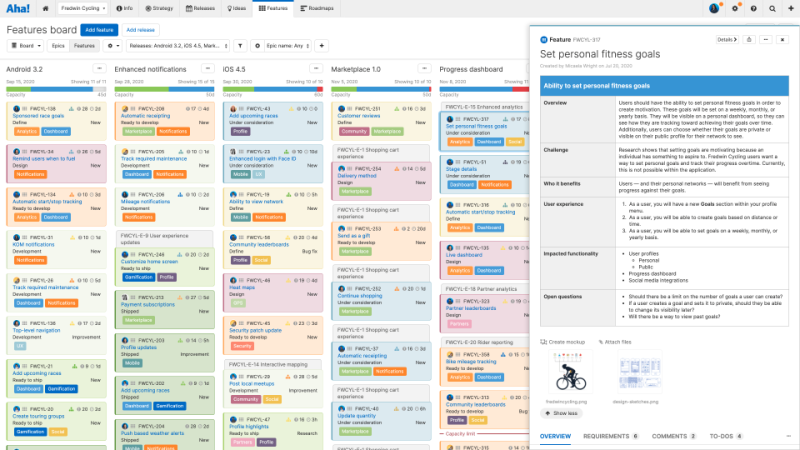
In their own words: “Where products come to life”
Brian de Haaf co-founded Aha! in 2013; at the time, a tool new to the product world. With a unique focus on roadmaps, over time it expanded to offering idea and organizational management, expanding even into the developer realm. Often seen to have focus on large project-focused enterprises, Aha! has established itself in the market from the beginning as a contender.
Founded in: 2013
Based in: United States
Employees on LinkedIn: 300
Funding: bootstrapped
Website: www.aha.io
How does it help with roadmapping and sharing roadmaps?
Aha! offers extensive sharing capabilities. However, their roadmaps are all timeline or Gantt-chart focused. As a product manager wanting to work with more modern ways of outlining strategy, such as outcome-based or theme-based roadmaps, you’ll find that near impossible to implement. You do have the ability to visualize goals and objectives, but all of these are set against a delivery timeline - meaning you would be operating as a project team, not a product team.
How does it help with discovery?
Aha! does have a feedback portal where you can engage with your customers, so if you’re looking to gain more insights, it’ll certainly provide assistance with that. That said, creating an internal feedback management system to understand how that feedback impacts prioritization of your ideas and supports further evidence is difficult, as these areas do not fully connect to one another.
How does it help with prioritization?
Their feedback prioritization is quite extensive, but fails to provide visibility over holistic problems. Aha! supports a project visualization, making strategy difficult to visualize overall.
How does it help with scaling teams?
Aha! provides flexibility with the support of custom fields, allowing you to set up inputs for your team as needed. Their reporting system is also quite substantial, which may help when reporting upwards.
How does it help with involving other team members?
Aha! has expanded its offering beyond roadmaps into a collection of products: Create, Ideas, Develop and Academy. The suite is a bit clunky at times, and its usability and UI are notoriously confusing and difficult to get around. With team members generally refusing to adopt other tools as it is, you may find it difficult to bring them onboard. That said, the Ideas section acts as a forum, so you might be able to get traction through there.
What is their pricing like?
Aha! packages their product in four plans for “Roadmaps” and two for “Ideas”. “Roadmaps” starts at $59 per user per month, paid annually and goes up to $149. “Ideas” is either $39 per user per month, paid annually or $59. You’ll need both products to cover all of your product management activities.
Anything else comes at an added cost.
Pros and Cons
Pros:
Advanced backlog management
Ability to create custom fields
Extensive tracking and reporting
Crowdsourcing and engagement with customers
Cons:
Roadmapping is timeline based
Loaded with features you may not ever use
Feature management is through voting, not problem solving
Hard learning curve
Rating
G2: 4.3 out of 5
Capterra: 4.7 out of 5
2. airfocus vs. ProductPlan

In their own words: “Everything you need in a strategic product platform”
airfocus is a new player in the product world, but in their short time they have blown things out of the water - for the best! airfocus understands the difficulties of product in practice, and have designed a tool that adapts to growing and scaling teams. With a unique take on flexibility, modularity, and personalization, its approach expands and grows with you.
From product strategy, discovery and roadmaps - all the way to insights management - their comprehension of unique product management workflows makes it adaptable in any setting.
Founded in: 2017
Based in: Germany
Employees on LinkedIn: 60
Funding: $10M
Website: www.airfocus.com
How does it help with roadmapping and sharing roadmaps?
airfocus has taken the approach of flexibility, and with that comes the ability to create both portfolio and individual roadmaps that roll upwards. Both can be shared internally and externally through quick links - ensuring transparency and collaboration right from the start.
It’s also very easy to get set up, with an offering of various types of templates available during onboarding. No matter though, whether you want to use one of their pre-populated setups or one of your own liking - it’s very easy to get started.
All templates and workspaces are 100% customizable, adding to the flexibility of the platform. Whether you need different views, fields, or user permissions applied - airfocus is truly a modular platform for the modern product team.
How does it help with discovery?
airfocus has a heavy focus on customer feedback, even more so with their recently released user portal, where you can engage with users directly. But that’s not all! You can also organize internal workflows for both feedback and opportunities, so you have full visibility over who is saying what, and gain the right insights to make decisions.
You can also set up custom workflows on all product levels (roadmaps, backlog, feedback), giving you full autonomy over how your product team manages its discovery process.
How does it help with prioritization?
airfocus has the most flexible prioritization configurations in any of the available product tools. After all, their original USP was to allow for teams to prioritize in any way they saw fit.
Each workspace can be customized to preference, so regardless of your framework methods, you can use any of them. There are also prepopulated templates for frameworks and backlog management, so you can hit the ground running ASAP. Each framework comes with an algorithm that will calculate a custom score, which you can then use to visualize how items compare to one another.
The platform also offers a Priority Poker tool, which helps teams align around opportunity priority. In it, a session can be started where team members score opportunities individually, and then discuss what the best way forward is.
How does it help with scaling teams?
airfocus’ vision was always to be a modular platform - that is, a tool that adapts and grows with scaling teams. This means that whatever your methodology of choice is, or how big or small your team might be, it will allow you to adapt easily to new ways of working.
The team is certainly strict about one thing: no two organizations or teams have the same way of working. With that in mind, while they provide useful guidance through their templates, tool tips, videos, and various educational content - you are still free to set up the tool in whichever way is the most helpful to you.
How does it help with involving other team members?
Collaboration is a breeze with airfocus thanks to its friendly UI. In addition to bringing your team onboard, you can also use forms, portals, and integrations to work with team members in other areas, reducing the friction in establishing the tool across your organization.
Their most popular integrations include tools such as Intercom, Jira and Asana, so you can set up a dynamic system across multiple teams.
What is their pricing like?
airfocus offers four pricing plans for their product. Pricing is based on paid seats, while also offering free viewers. The smallest is $19 per user per month, billed annually. The next larger one is $69. The two upper tiers are custom pricing, also billed annually.
Pros and Cons
Pros:
Multiple integrations with development tools like Jira, Trello and AzureDevops
Ability to create and share roadmaps
Portfolio view of multiple roadmaps
Customizable fields and views
Custom prioritization frameworks + priority poker
Customer portal and insights app
Good UI, easy setup
Cons:
Modularity can take bit of time to get used to
Rating
G2: 4.4 out of 5
Capterra: 4.5 out of 5
3. Asana vs. ProductPlan
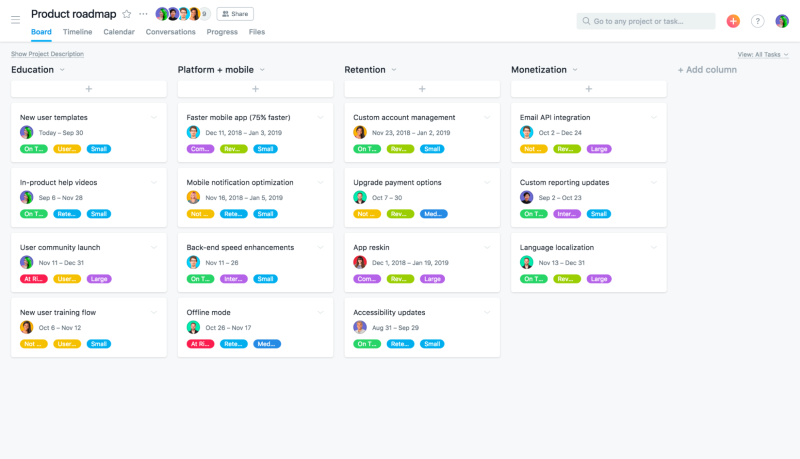
In their own words: “Align teams and drive revenue with a single platform.”
Asana is one of the most well-known task management and development tools. In recent years they’ve expanded their platform to support various other teams, particularly anyone needing task-oriented management.
Founded in: 2008
Based in: United States
Employees on LinkedIn: 2500
Funding: $453.2M
Website: www.asana.com
How does it help with roadmapping and sharing roadmaps?
Asana’s use cases don’t really tackle the needs of product managers, beyond the use of timelines that is. While it’s really great at allowing you to manage your everyday tasks, roadmapping (as we all know) entails a different kind of process. If you’re looking to work with higher level roadmaps such as the now, next, later structure, you’ll find it next to impossible to set up.
You could hack around it by creating a custom board, but as things are linear it’ll start breaking down a little bit as you’re looking to gain a holistic view of your entire portfolio.
How does it help with discovery?
As a task-oriented tool, Asana isn’t really set up to allow you to gather insights, feedback, or collect any kind of research. While it does have a workflow aspect that you can customize, you’d still find it difficult to allocate the necessary insights gained from discovery to your ideas.
How does it help with prioritization?
Asana is highly customizable and flexible, so you could add your own custom framework if you needed, but optimizing the algorithms would be tricky. They do offer pre-defined labels of high, medium and low - which at a simple level actually gets things done if you’re into a more simplistic approach.
How does it help with scaling teams?
There are no red flags when it comes to scaling teams - if anything, its workspaces, flexibility and customizability make it quite easy to adopt and adapt to growing teams.
How does it help with involving other team members?
Asana has taken a lot of care to create a UX/UI that is truly delightful, and you should encounter minimum friction with your team. After all, we all have to manage our projects!
What is their pricing like?
Asana offers three tiers paid per user, billed annually: free, $10,99 and $24,99.
Pros and cons
Pros:
Easy-to-use
Interconnected apps and workflows
Plenty of integrations to choose from
Cons:
It’s a task-management tool, not a product tool
No space for feedback or insights management
No ability to create product roadmaps
Rating
G2: 4.3 out of 5
Capterra: 4.5 out of 5
4. Jira vs. ProductPlan
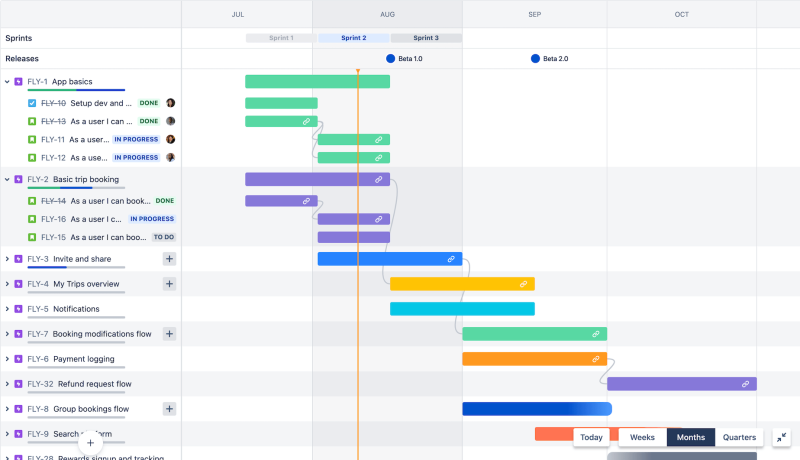
In their own words: “Move fast, stay aligned, and build better - together”
The Atlassian suite is known throughout the world, with Jira being its golden nugget. As a development tool and alongside the rest of the suite, it interconnects support, operations, and project teams alike. In addition, they have over 3000 integrations to choose from, putting cross-tool collaboration at the forefront.
Founded in: 2002
Based in: Australia
Employees on LinkedIn: 15.300
Funding: $210M (Secondary market) + $462M(IPO)
Website: www.jira.com
*Data for Atlassian, Jira’s parent company
How does it help with roadmapping and sharing roadmaps?
Jira does offer roadmapping capabilities - both board and timeline views - but those views cannot be shared outside of the Atlassian ecosystem (unless you purchase Jira Premium or Enterprise.) This causes issues when wanting to share the roadmap externally, particularly with board members or customers (unless you’re willing to give access to it!)
As a delivery tool, it allows teams to see work all the way down to the task-level, but gives less in the way of understanding outcomes, goals, and potential risks or benefits associated with your roadmap opportunities. Its approach is currently quite simplistic, but it might just do the job for you if you’re looking to just keep your team aligned for the time being.
How does it help with discovery?
While you may be able to set up a discovery board or workflow, you’ll need to set it up in a custom manner with a few integrations in mind. Much like other do-it-all tools, this will require your IT manager to approve and set up your integration, causing a bit of a set up delay.
How does it help with prioritization?
Custom fields are necessary to set up more advanced frameworks, and will require knowledge or assistance of someone that has the right permissions to do that for you (like your IT manager.) Again, this causes delays in getting set up quickly, and would be harder to maintain in the long-run.
How does it help with scaling teams?
Jira (and the whole of the Atlassian suite) was set up to be scalable - there’s no arguments there. With scalability, however, come more complicated IT processes and permission levels. This means you’ll need someone else’s permissions to set up your own working space, and as your team grows and changes need to be made - those may be delayed as you will have to rely on someone else to approve and make those changes for you.
How does it help with involving other team members?
Atlassian always offers a wide variety of advanced permissions you can assign to team members (for better or for worse!) Its UI is tricky to navigate, and tends to cause a lot of friction when it comes to extending the tool with business-facing team members such as marketing and sales. The Atlassian team is also notorious for shifting things around without telling anyone, so be prepared to not find the menu item you were looking for.
A good product team must be able to work closely cross-functionally, and if others refuse to adopt your product tool, teamwork will just be that much harder.
What is their pricing like?
Jira is available at four different prices: free, $7,50, $14,50 per user, per month (no matter if paid annually or monthly). Lastly, an enterprise tier, only available with annual billing from 801 users at $10,70 per user per month.
Pros and cons
Pros:
Great for software development teams
Over 3000 apps and integrations available
Customization of boards, reports, timelines, and views
Good scalability with larger teams
Cons:
It is not a product management tool
Time-consuming management process
Confusing layout, configuration, and UI
Rating
G2: 4.2 out of 5
Capterra: 4.4 out of 5
5. Productboard vs. ProductPlan
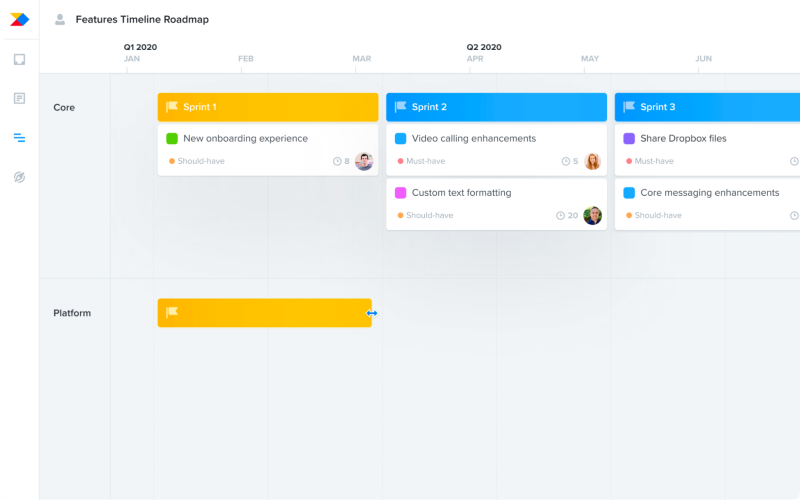
In their own words: “Productboard helps product teams understand what customers need, prioritize what to build next, and align everyone around the roadmap.”
Productboard is one of the top contenders in the product world, focusing on customer-centricity and roadmapping. With offices in San Francisco, Prague, and Vancouver, Productboard has become a global company in recent years, expanding on their platform in recent years.
Founded in: 2014
Based in: San Francisco, California
Employees on LinkedIn: 500
Funding: $125M Series D
Website: www.productboard.com
How does it help with roadmapping and sharing roadmaps?
Productboard is primarily timeline-focused, with templates such as “release roadmap” and “timeline roadmap” readily available. While they do offer a now, next, later roadmap - they seem to have misunderstood that these are not focused around releases. Their roadmap also bypasses the idea of initiatives entirely, allowing you to put features directly on the roadmap. This misses out on the ability to provide product managers with a more holistic understanding of problems, jumping directly to solutions and leaning towards feature-factory practices. That said, all of their roadmaps are easily shareable, both through links and through a customized portal.
How does it help with discovery?
Productboard has a user portal that you can use to gather feedback around items in discovery, or just gather general feedback. However, it’s important to note they treat everything in your product backlog as a ‘feature’ - not as an opportunity, experiment or idea - once again funneling you into a solution space, rather than a problem space.
How does it help with prioritization?
Productboard does offer customization to a certain extent, and you are free to set up any prioritization you’d like, such as RICE. That said, because there is a lack of initiatives on the roadmap level, the ability to take other factors into account with the initiative (like objectives, vision, theme) are entirely missed.
How does it help with scaling teams?
Productboard does have the concept of multiple workspaces, but these are disjointed from one another. Otherwise, you are able to still manage multiple products out of a single workspace. If your team does have the benefit of being able to work that way, then you won’t run into any issues. However, if you’d like to provide your various teams with a single source of truth while allowing for more flexibility, you will run into some problems.
For starters, working from a single space means everyone has the same workflows, processes, and set of custom fields. This leaves little in the way of team-level customizations.
If you do choose to go through the multiple workspace route, because they are disjointed, you won’t benefit from cross-team collaboration or being able to roll up these various workspaces into a single portfolio that is visible to your entire team.
How does it help with involving other team members?
Productboard’s UI, while delightful to look at, is at times a bit confusing. It takes a little while to get onboard with the specific frame they’ve set. With that in mind, it’ll likely be easier to get your team onboard via the user portal, as it’s a lot easier to use.
What is their pricing like?
Productboard has four different price plans, billed per user per month. Starting at $20, continuing with $80, with the upper two plans available on request.
Pros and cons
Pros:
Focus on customer feedback and insights
Public portal for customer engagement
Cons:
Mixed messaging around roadmaps and product approach - is it project or product based?
Price can be quite steep
Rating
G2: 4.3 out of 5
Capterra: 4.7 out of 5
6. ProdPad vs. Productboard
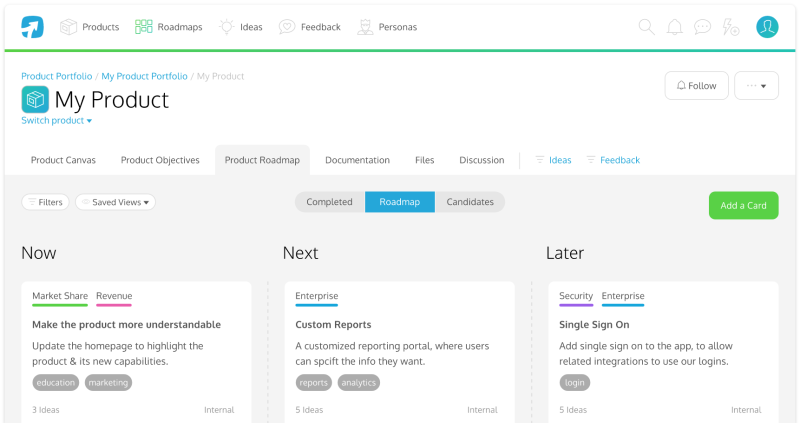
In their own words: “Roadmap, idea, and feedback management that ties actions to outcomes”
Small but powerful, ProdPad is one of the few outcome-focused tools in the product world. Ensuring you get access to best practices right from the start, this is a great tool for any product team looking to make the switch to better product practices.
Founded in: 2012
Based in: UK
Employees on LinkedIn: 20
Funding: Bootstrapped
Website: www.prodpad.com
How does it help with roadmapping and sharing roadmaps?
The founders behind ProdPad created the original Now, Next, Later roadmap - so if there’s anyone that knows about them, it’s this crew. Their roadmaps are quite delightful and easily shared via a PDF, URL or embed code.
All roadmaps roll up into a portfolio view, so you can gain a holistic view of your product.
That said, it does have certain limitations, like dependency tracking across products.
How does it help with discovery?
ProdPad does have a portal and widget that you can use to gather feedback from customers, as well as the ability to set up custom workflows. However, these things are still quite limited by the fact that all teams have to follow the same structure. Customization on the widget and portal are a bit limited, and are created and shared independently from the roadmap. Likewise, there’s limitations on creating a custom feedback workflow, as they force you to work with their own.
How does it help with prioritization?
ProdPad does offer a very basic impact vs effort prioritization scale, which you can visualize as a fibonacci sequence, 1-10 scale, or tshirt sizes. However, they offer no customization of prioritization frameworks beyond that, so you must use the options they offer. If you’re happy with the basic setup, you won’t have any issues comparing items with one another on their priority chart, enabling you to make smart decisions for your team.
How does it help with scaling teams?
As we know, as teams grow and adapt you will find that different teams may have different needs. And when you need your team to work from a single source of truth, that’s when things start getting really tricky. ProdPad forces everyone to work out of a single workspace, with no customization over fields, workflows or processes - meaning everyone has to work in the exact same way. This will certainly cause issues with scalability.
How does it help with involving other team members?
The lingo can get a little confusing for team members, given that everyone has access to all features in the platform at the same time. Will everyone know if they have to add an idea or a piece of feedback? What is the difference? Unfortunately, with ProdPad there is little to no modularity with permissions - meaning if you choose to use all areas, everyone has access to all areas, making it difficult to tell users where they have to go and why. They also have no integrations with commercial-minded tools such as Intercom, Zendesk or Salesforce - making it harder to adopt with your business-facing teams.
What is their pricing like?
ProdPad’s pricing is based on modules and power-ups.
Their base modules are all $20 per editor/per month for access to roadmaps, ideas and feedback. Their power ups are all $10 per editor per month, and include things like portfolios, OKRs, publishing and portal access.
Pros and cons
Pros
They’re the roadmapping experts
Ability to create a portfolio view
Have access to feedback and portals
Cons
No customization of fields or views
No customization of workflows or processes for backlog or feedback
No customization of priority frameworks
Little in the way of scalability for various teams
Rating
G2: 4.2 / 5
Capterra: 3.8 / 5
7. Roadmunk vs. ProductPlan
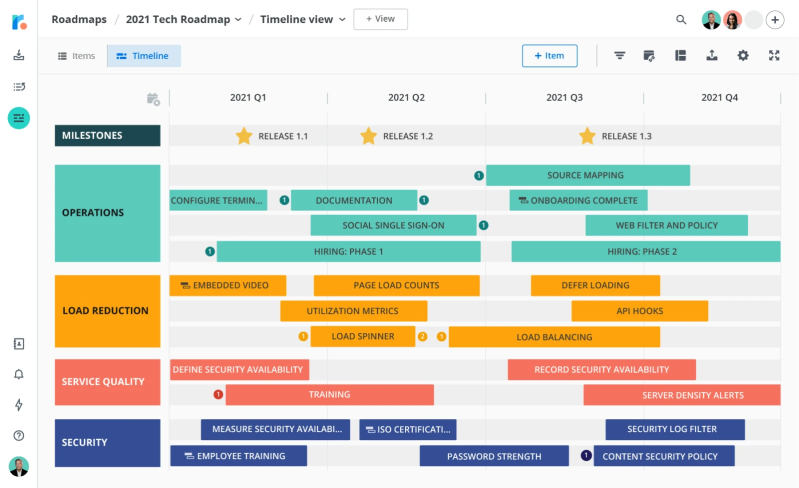
In their own words: “Create and present boardroom-ready roadmaps”
The Canadian startup Roadmunk burst into the scene as a roadmap-only solution, and over time extended their offering to include backlog and feedback management. Now as a more full product management suite, they’re a contender in the product world.
Founded in: 2012
Based in: Canada
Employees on LinkedIn: 60
Funding: $1,7M (bought by Tempo at an undisclosed price)
Website: www.roadmunk.com
How does it help with roadmapping and sharing roadmaps?
Roadmunk provides a vast library of roadmap templates, including timelines and outcome-based roadmaps across various themes, industries and project types.
All roadmaps are easy to share, and come in formats such as CSV, PNG, HTML and publishing to a URL.
How does it help with discovery?
Roadmunk lacks some discovery focus. They’re heavy on project focus, giving you access to timeline roadmaps and task management, but fails on the discovery side. As they say themselves: they help you “commit to product ideas”, which is far from being able to run a discovery process to ensure you’re not committing to the wrong ones.
They do offer a portal and feedback inbox, but they lack extensive feedback management. There are only two statuses available on the inbox: “New” and “Processed” - but nothing in between. While it’s a good first go, it would fail scaling upwards as processes become more detailed.
How does it help with prioritization?
Roadmunk only offers two prioritization frameworks: impact vs effort and RICE. It does also offer other data points such as time estimations and revenue - once again, very project and output-oriented. If you are happy with a really simple framework, this might just work for you. However, if you wish to add more into consideration, you may find it a bit too restrictive.
How does it help with scaling teams?
Roadmunk is great for smaller teams, but its limited customization, workflows and processes, would make it hard to scale any team. They try to force everyone into a box, but the reality is, not everyone fits into the same box.
They also only offer two integrations out of the box: Jira and AzureDevops. For everything else, there is an API available which you would need your team to find development time to implement with any other tools.
How does it help with involving other team members?
It is easy to collaborate and mention other team members, but their UI remains difficult and clunk throughout, making adoption potentially a friction point.
What is their pricing like?
Roadmunk offers four price tiers starting at $19 per user per month, billed annually. The second and third tiers are $49 and $99 respectively. Enterprise pricing is available on request only.
Pros and cons
Pros:
Over 50+ templates available in their roadmap library
Has a feedback portal and inbox
Has integrations with Jira and Azure Devops
Cons:
Difficult UI
Restrictions on prioritization and fields
No flexibility for feedback management
No scaling options
Rating
G2: 4.1 out of 5
Capterra: 4.4 out of 5
8. Trello vs. ProductPlan

In their words: “Trello brings all your tasks, teammates, and tools together”
Trello and their easy to use boards have been well-known for years, ensuring you’re able to work with your team - and across teams - to organize projects across your company. Recently acquired by Atlassian, they are now part of their ecosystem to expand on task management and developer tools.
Founded in: 2010
Based in: United States
Employees on LinkedIn: 100
Funding: $10M Series A + acquired by Atlassian for $425M
Website: www.trello.com
How does it help with roadmapping and sharing roadmaps?
Trello gives you access to individual boards, each of which have custom fields, labels, and “power ups” (integrations) that you can work with. That said, as a task-based tool, it’s not really meant to be used as a roadmap.
It’s important to remember that a Kanban board is not the same thing as a roadmap - just because they look the same, doesn’t mean they operate the same. So while you can achieve some semblance of a roadmap, it’s not really its main purpose.
How does it help with discovery?
This is where things can get really hacky with Trello. You can set up a custom discovery board, and surely you can set up a different customer-facing board to act as your portal. Of course, you can then also create another board to manage your product backlog, and then create a separate board to keep track of your development.
If this is giving you a headache just reading about it - imagine having to work with it.
You can try and make it work, but it simply won’t scale long term.
How does it help with prioritization?
You can make use of Trello’s custom fields and labels to prioritize items, but its nature as a task-based tool means that you still need to find a way to consider items across multiple boards. Trello is still really great at allowing you to visualize and prioritize tasks, not more holistic items across multiple teams and portfolios.
How does it help with scaling teams?
Trello is great for scaling. Scaling task management, that is. Boards can easily get out of hand, and you’ll need to start creating connections between them. This isn’t impossible, but it’s worth keeping in mind. Remember, we are addressing product management scalability, not task management scalability. As a task manager, Trello remains one of our favorite tools.
How does it help with involving other team members?
Trello is really straightforward and easy to use, so you won’t have a lot of issues involving other team members.
What is their pricing like?
Prices start at $0, then move up to $5, $10, and $17.50 per user per month, billed annually.
Pros and Cons
Pros:
Really easy to get started
Power-ups with hundreds of other tools
High customization
Cons:
It is not a product management tool
Its focus is on task management
Limits on workspaces, boards and commands unless you’re on Enterprise
Difficult to create and interconnect workflows and view them holistically to understand their impact on each other
Rating
G2: 4.4 out of 5
Capterra: 4.5 out of 5
Conclusion
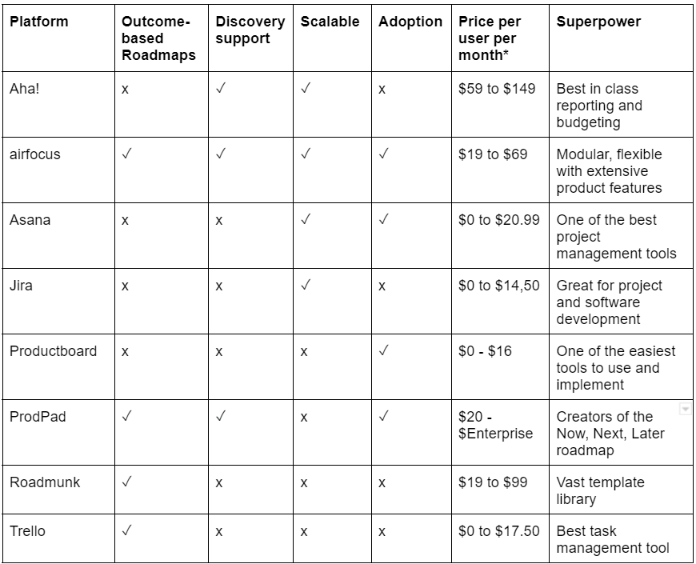
* public prices only, billed anually. All companies offer custom enterprise prices on demand.
ProductPlan had a solid vision, but failed to adapt over time. The reality is, product managers do a lot more than just build and share roadmaps. Most importantly, those roadmaps must be informed by our discovery, research, and feedback - areas which ProductPlan has failed to deliver on. If all you need is a way to quickly whip something up, this may just be the tool for you. However, upkeep will be tricky!
If you want to learn more about applied modern product management, feel free to check out our academy guide on just that.

Andrea Saez
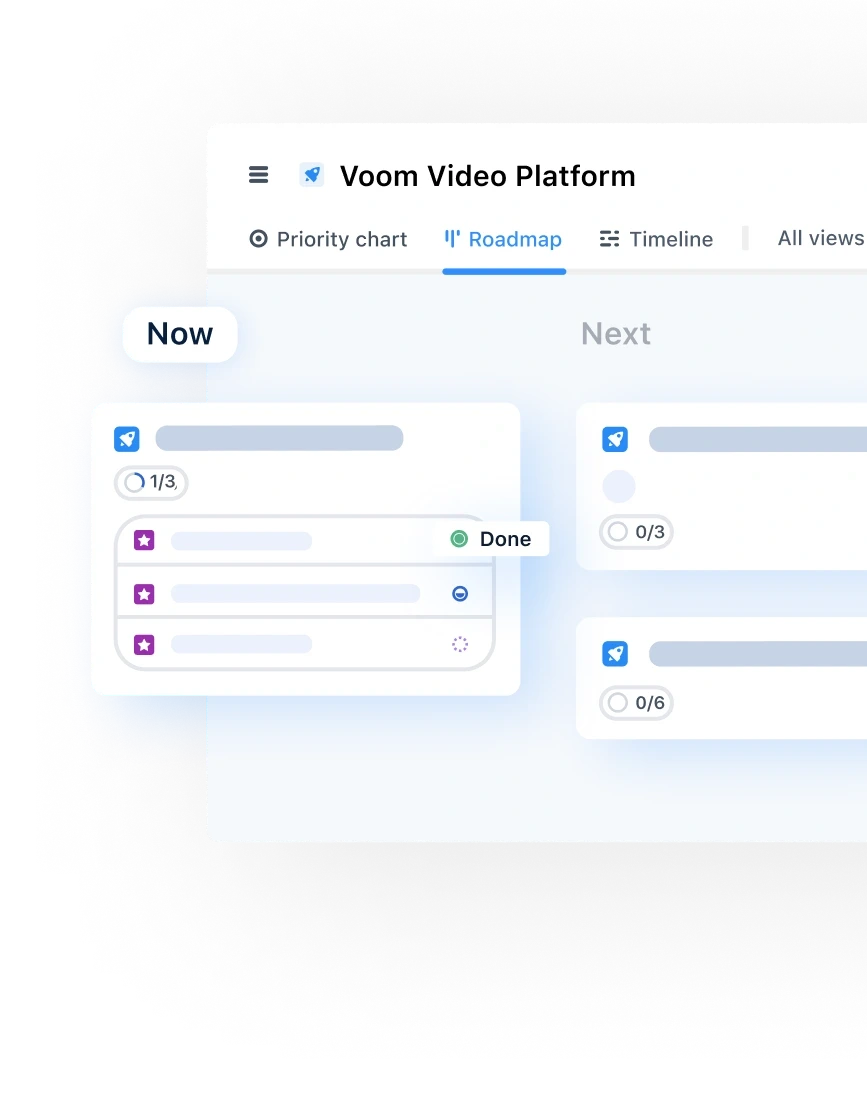
Read also





Experience the new way of doing product management

Experience the new way of doing product management


